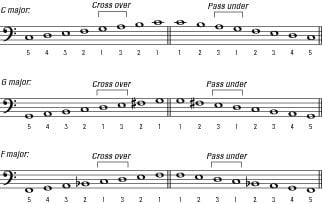Your left hand plays a supporting role when you’re at the piano. But even though it doesn’t often get to play the melody, your left hand adds some crucial bass notes and accompaniment.
If you consider middle C the middle of the piano, you generally play notes above middle C with your right hand and those below middle C with your left. The lower staff is the bass clef.
The most common and comfortable starting positions for your left hand mirror those for your right:
C position: Your left pinky (also known as LH5) on the C an octave below middle C. The other fingers on your left hand rest on the nearest D, E, F, and G, respectively.
G position: LH 5 moves down to G, the bottom line of the staff, and your other fingers move accordingly.
Scales aren’t the most exciting things to play, but by playing left-hand scales you unwittingly master the following music essentials:
Reading the bass clef
Playing with the correct fingering
Using nifty patterns and harmonies
Realizing how much you miss playing with the right hand
You can use the same fingering, both up and down the scale, for all of the scales in the following figure. The C major scale has no sharps or flats, G major has one sharp, and F major has one flat.

As with right-handed playing, use the correct fingerings as indicated by the numbers above each note. How and when you cross your fingers is very important for obtaining a smooth sound and comfortable left-hand technique.

